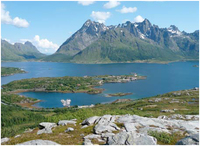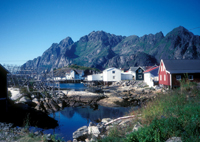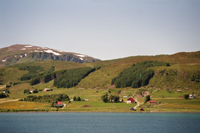
|
| Foreign tourists expressed the most positive opinions about rugged, rocky coasts. Photo: Hans Tømmervik (Norwegian Institute for Nature Research) |

|
| Picturesque fishing villages were also popular scenes. Photo: Jens Kr. Steen Jacobsen (Institute of Transport Economics) |

|
| Tourists did not find spruce plantations particularly attractive. Photo: Jens Kr. Steen Jacobsen (Institute of Transport Economics) |
Jens Kr. Steen Jacobsen, jsj@toi.no and Aslak Fyhri, af@toi.no, Institute of Transport Economics, Oslo
Hans Tømmervik, hans.tommervik@nina.no, Norwegian Institute for Nature Research, Polar Environmental Centre, Tromsø
One of the most significant visual alterations – in Northern Norway and elsewhere – is the general re-growth and overgrowth of former farmlands. Encroaching vegetation may obscure vistas for sightseers, conceal cultural remains, decrease biodiversity, reduce the local population’s access to valued areas, and probably also cause some locations to lose their “placeness”.
Landscapes always possess character that derives from how and why people know and use them. In Northern Norway, these could be farmland, bird sanctuaries, cloudberry moors, one’s native district, and the sites visited on family outdoor excursions and holiday trips.Often, ideas of local identity are imparted by landscape features: cultural markers such as distinctive vernacular architecture and other tangible heritage.
Many of the most appealing and dramatic sceneries around the world also constitute the livelihood of tourism- related industries with a finite – and dwindling – number of destinations at their disposal. Among such precious vistas are parts of the archipelagos of Lofoten and Vesterålen, the case area of “TOPCOAST”, a multidisciplinary study funded by the Research Council of Norway.
Parts of this project responded to a deficiency of academic research on landscape perceptions among tourists. The main objective was to explore international tourists’ landscape perceptions in Vesterålen and Lofoten, focusing on three different concepts thought to be important for tourists’ landscape preferences: typicality, vegetation lushness, and degree of human influence.
Photo-based interviews and sorting procedures were employed among a sample of international tourists while they were visiting the case region. Although general studies of landscape perception and scenic beauty represent some well-established traditions, very few academic studies of tourists’ perceptions of and preferences for agriculturally related landscapes have been conducted. Even fewer studies encompassing visualisations of landscapes have been conducted through representational options such as photographs. In most research, landscape quality is indicated by the human observers’ expressions of preference (choice, like/ dislike) or judgments and ratings of visual aesthetic quality – for instance scenic beauty.
As basis for the sorting procedures, twelve colour photographs were employed, all presenting landscapes that tourists are likely to encounter if they travel along or in the vicinities of the route of the express coastal liner (Hurtigruten) through the archipelagos of Lofoten and Vesterålen. Participants were given several sorting tasks (free sort, typicality, lushness, and preference) and were asked to comment on their impressions of the pictured landscapes, thus providing both quantitative and categorical data. Data were then subjected to multidimensional scaling analysis.
The most preferred landscape was a barren coastal rock landscape, followed by fishing hamlets and deserted farmland dominated by meadow buttercup (Ranuculus acris), cow-parsley (Anthriscus sylvestris), and rosebay willowherb (Chamaenerion angustifolium). The least preferred landscapes were abandoned meadows covered with tufted-hairgrass (Deschampsia cespitosa) and coastline hillsides with spruce plantations. It should be mentioned that the area of forested land in the study area increased by more than 30% during the period 1985–2007, mostly due to reduction in cultivation, grazing and forestry.
Preference ratings did not unequivocally support previous findings that lush vegetation and little human influence are important aesthetic qualities. On the other hand, there is an indication that abandoned farmland and encroaching forests in costal landscapes only play a minor role for foreign tourists. Visitors from abroad appear to appreciate mountains, barren coastal rocks and fishing hamlets more than an active agricultural landscape. The findings emphasise the need for taking into consideration typicality of settings in future landscape research.
For further reading:
Fyhri A, Steen Jacobsen JK, Tømmervik H. Tourists’ landscape perceptions and preferences in a Scandinavian coastal region. Landscape and Urban Planning 2009, 91:202–211.





